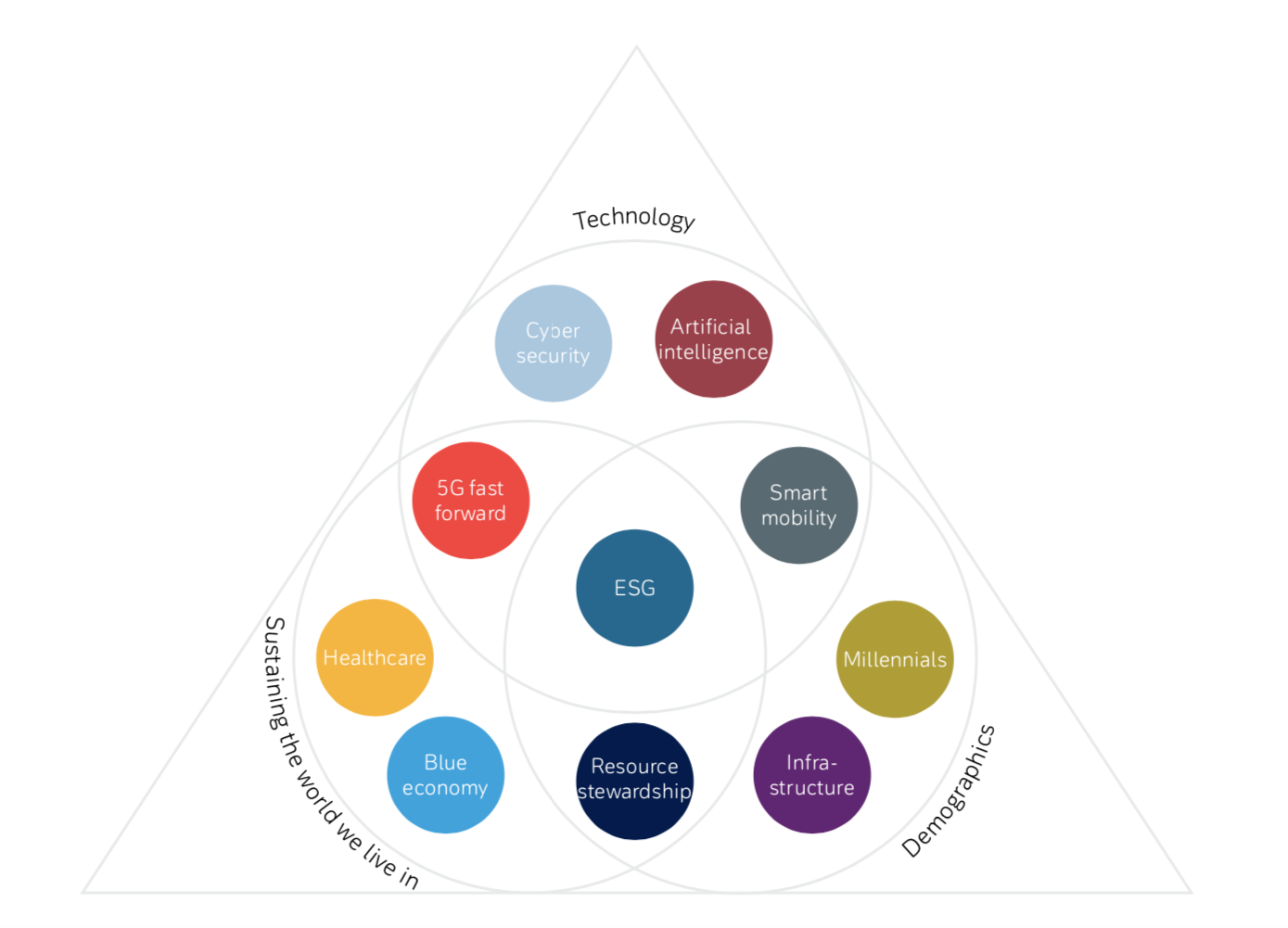
Key investment themes
• Technology • Demography • Sustaining the world we live in
Please note: this article is more than one year old. The views of our CIO team may have changed since it was published, and the data on which it was based may have been revised.
Our key investment themes sit within the three dimensions of technology, demographics and sustaining the world we live in – in short, the TEDS triangle. All have both immediate and long-term relevance and should continue to provide interesting investment opportunities.
Cyber security
- Rationale: The world is more and more digitally interconnected – by 2026 almost 26% of the world’s GDP could depend on internet-based and digitally connected industries[1]. Cyber attacks are estimated to cost over USD1tn with a possible increase of 50% in the next two years[2]. Not only companies but societies and governments are affected. Healthcare is an exposed sector.
- Key trends: The diffusion of mobile communication and implementation of 5G technology have increased the focus on data security in various forms, including interdependencies between 5G networks and other critical systems as well as risks related to end user devices. A stricter regulatory framework and standardisation may have to be considered. The growing importance of artificial intelligence (AI) has relevance for cybersecurity, for example through improving metrics and system resilience. Our increasing interactions with physical devices around us provides another challenge for cybersecurity if we are to achieve end-to-end security.
- Risks: General risks around tech stocks, including inflation and geopolitical tensions.
Smart mobility
- Rationale: Changing technologies and shifting consumer habits are challenging the automotive sector, as well as regulatory measures targeting zero net emissions. The costs of manufacturing electric vehicles (EV) are dropping faster than initially expected. The simplicity of EV design versus traditional car models will also bring down manufacturing costs. The concept of smart mobility extends beyond individual vehicles into transport infrastructure in general.
- Key trends: The following measures are likely to be important in the next 12 months. First, electricity provision will use EV batteries to power households, leading to more efficient management of power grids. Second, advanced safety technologies like pedestrian detection and emergency braking will be implemented before a fully autonomous car is available. Third, smart connectivity and automation will make it easier for ride-sharing services to increase vehicle capacity, reduce congestion, and minimise both local and global pollution even further. Fourth, smart mobility will help develop unmanned package delivery, a sector given impetus by the pandemic.
- Risks: Regulatory issues create a range of risks. Any deferral or moratorium of emission reduction agreements could impact development. Attention may also focus on the human and environmental costs of metals such as lithium and cobalt.
Artificial intelligence (AI)
- Rationale: We may now be at a pivotal point for the adoption of AI given massive strides in computation power and data generation/storage in recent years. AI and the related domains of machine learning (ML) and deep learning will help make sense of that data, with a scaling-up of venture capital funding for AI start-ups led by China and the U.S.
- Key trends: The coronavirus pandemic has accelerated use of AI in the healthcare sector to diagnose patients, monitor epidemics and reduce the drug and vaccine development cycles. “Remote working” and digitalisation has encouraged AI-powered chatbots and virtual customer support assistants, often provided in the form of AI-as-a-service (AIaaS) model, rather than developed in-house. AI is increasingly important in the financial sector, in the search for market outperformance and driving operational efficiencies (e.g. in risk management). Machine learning (ML), which appears to be taking around half the total amount going into AI funding.
- Risks: Political risk exists at many different levels e.g. through AI displacing human labour. The importance of China in the sector may also create geopolitical risks.
5G
- Rationale: As it is implemented, 5G will support rapid growth in many technology and communication services companies and subsectors. 5G investments can include those in semiconductors, telecom and carrier services, and in infrastructure required for the technology. They will be intertwined with other tech themes, such as AI and machine learning, digitalisation, and the growth of the Internet of Things, encompassing a wide range of technologies.
Past investment has focused on the development of 5G technology, but we are now at the stage of building and expanding the 5G network. This focuses on demand for semiconductors and raw materials, and the search for infrastructure, such as land for cell towers and data centres.
- Key trends: Asian countries may be more attractive in the development of 5G technologies, while in the U.S. and Europe economies, the focus is on building cell towers and network dominance. Two areas of particular current interest may be the Internet of Things (IoT), and the carrier companies for 5G. IoT devices relating to 5G include semiconductors and sensors, smart homes, and everyday utilities and tools such as watches and speakers. The telecom and carrier space remains another major area for investment. 5G rollout may further worsen semiconductor shortages.
- Risks: 5G mobile networks will continue to create political stress. China’s first- mover status in many emerging markets may limit developed market firms’ ability to expand, leading to pressure to limit Chinese influence. The U.S. and other markets have already restricted the use of Chinese hardware in the 5G space for security reasons.
Infrastructure
- Rationale: There remains a great need for infrastructure investment – for example, according to the World Bank, 1 billion people lack electricity, and 4 billion people lack internet access. Infrastructure also needs to be seen in the context of the target for net-zero greenhouse gas emissions in many economies. This is a sector that thinks long-term – but where innovation (e.g. via data, interconnection and automation) is forcing rapid change.
- Key trends: Alongside innovative technologies, traditional infrastructure assets (bridges, toll roads, ports, airports, railways) could be attractive to investors, given reopening, fiscal stimulus, linking of fees to inflation, barriers to entry, stable cash flows (with the obvious exception of the coronavirus pandemic) and a usually inelastic demand pattern for utilities and energy. Possible accelerated action on transport decarbonisation, renewable energies and digitalisation. The nature of private/public interaction may also change.
- Risks: Policy stimulus has created macroeconomic risks (with relevance for infrastructure priorities). A lifecycle assessment of infrastructure projects in terms of potential costs and returns is vulnerable to climate change and offsetting measures.
Healthcare
- Rationale: We expect the growth in global healthcare spending to continue to outpace the expansion in GDP, partly due to ageing populations and increasing affluence in many emerging markets. Multiple forces are driving a transformation of the entire healthcare value chain, across the four domains of care service provision, medical devices, pharmaceuticals and healthcare finance. The medical device market, for example, is expected to almost double in size (to USD800bn) over the next decade.
- Key trends: Healthcare faces a period of readjustment as the pandemic is brought under control. Longer-term trends may be heavily influenced by technology, e.g. wearables, to diagnose, treat and monitor patients without human contact, with implications for artificial intelligence (AI) in the care of people, wearable medical equipment, remote patient monitoring devices, electronic health records (EHR) and so on.
Another trend may be for patients to take more responsibility for their health in the future, transforming healthcare from an episodic service to a lifelong process of managing and maintaining individuals’ health.
- Risks: Rapid change may make it difficult for companies to justify their valuations in the future and to defend their market positions against new entrants, especially from the technology space. Regulation (particularly in terms of data) could represent a major threat for the industry.
Millennials
- Rationale: Millennials (individuals born in the 1980s and 1990s) are associated with a more purpose-oriented way of thinking. Prestige and earning money may be less relevant for them. They have lived through several financial crises, and are the first generation to face in full the consequences of climate change. Following the millennials these might therefore mean addressing ESG concerns through investment choice or, alternatively, looking at areas of high millennials’ consumption such as social media, entertainment or popular brands.
- Key trends: Four issues could be particularly important. First, inequality: asset prices, decreased labour share and job outsourcing have reduced opportunities for millennials to build wealth (apart from inheriting). Second, politics: the growing proportion of millennials in the population has left them more able to influence the political agenda (e.g. around the redistribution of wealth). Third, population ageing: this makes it likely that millennials’ taxation will rise, and they may have to work longer. Fourth, shrinking labour force: this may give millennials greater bargaining power and the chance to shape their working conditions (work-from-home, work-life balance, purpose thinking).
- Risks: Many millennials-relevant companies are “growth” stocks, making them potentially vulnerable to a reversal of the current low yields environment. (If yields increase, they could suffer from a higher cost of capital, as future earnings would be more heavily discounted). Companies with large market shares could also face a higher degree of regulation in future.
ESG
- Rationale: The coronavirus pandemic has important social and environmental implications, with many investors taking a closer look at ESG (environmental, social or governance-focused) investments – sustainable funds have received record inflows. In future, ESG integration will become more important for risk management purposes, due to its perceived resilience in times of crisis. Regulators increasingly see the need to quantify environmental, social and governance risks alongside financial risks: note, for example, Europe’s Sustainable Finance Disclosure Regulation (SFDR).
- Key trends: According to some estimates, ESG assets could account for around a third of total assets under management in the next five years, but this form of measurement does not capture the growing impact of ESG on corporate investment overall. We expect the Biden administration to drive change in the climate and green space, with growing ambition around limiting climate change evident at the COP26 summit of Paris signatories in Glasgow in November. Net-zero carbon emissions, finding ways to finance the transition, providing financial assistance to countries most affected by climate change, and ensuring a just transition for those affected by the clean energy transition are likely to be key topics.
- Risks: It is estimated that around 20% of the MSCI World investment universe is directly exposed to transition risks (policy, liability and technology), including “asset stranding”.
Resource stewardship
- Rationale: Economics, urbanisation, technology and regulation argue for better resource stewardship. The emphasis on “greening” the waste sector through the five Rs (“recover, recycle, reuse, restore and reduce”) is leading to new markets, changes in supply chains and greater capital expenditures. The total global waste management market (e.g. industrial waste, wastewater and sewage, sustainable packaging, and e-waste) is estimated to be worth around USD1tn. Investable sub-themes in this space include alternative energy and fuel, technology, products and services in the water value chain, decarbonisation, digitalisation and decentralisation of the global energy system.
- Key trends: Greater interest in sustainability in general due to the pandemic, and increasing regulations. E-waste is a particular problem: only one-fifth was collected or recycled in 2019 and, according to a United Nations University study, the volume of e-waste is predicted to grow by nearly 40% by 2030. Meanwhile, recycling industries here and in other areas are growing strongly: some estimates point, for example, to a near 45% rise in the global plastic recycling market over the next five years.
- Risks: Waste management is closely interlinked with economic cycles, and governments and companies may want to defer change on this large-budget item. Secondary raw material recovery (e.g. in the form of waste-to-energy processes) is exposed to commodity price volatility.
Blue economy
- Rationale: The blue economy is becoming increasingly important in discussions about resource management and economic growth. Oceans are the world’s eighth largest economy, generating USD2.5tn of goods and services and with a combined global ocean assets valued at USD24tn, according to the WWF. In some East Asian countries, the ocean economy can account for 15-20% of total GDP. But this economic resource is coming under great pressure from overfishing and environmental destruction – about half the world’s coral reef system has been destroyed.
- Key trends: The introduction of the International Maritime Organisation’s ambitious carbon emissions goals for 2030 and 2050 has already had a direct impact on the sustainability of the maritime environment as ships have shifted to new fuels. The shipping industry is pursuing efficiency gains in others areas (e.g. routing, turnaround time, digitalisation of data). The marine biotechnology industry is another area experiencing rapid development. Marine organisms may prove helpful for developing new drugs for various diseases.
- Risks: Investments would be subject to immediate onset risks (e.g. tropical cyclones, flooding and inundation); slow onset risks (e.g. sea levels, acidification, food security issues, declines in biodiversity) and risk multipliers (e.g. pollution, resource exploitation, land-use changes).
Our full CIO Insights report “Signs of light" includes economic forecasts for 2021 and 2022, along with individual asset class outlook summaries and forecasts to end-March 2022. Please refer to the Important Notes at the end of the report for disclosures and risk warnings.
To download a printer-friendly PDF of the full report, please click here.
Past performance is not indicative of future returns. Forecasts are not a reliable indicator of future performance. Your capital may be at risk. Readers should refer to disclosures and risk warnings at the end of this document. Produced in March 2021.


